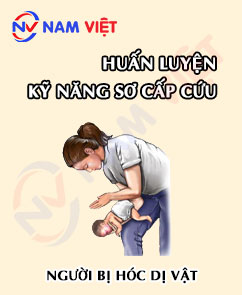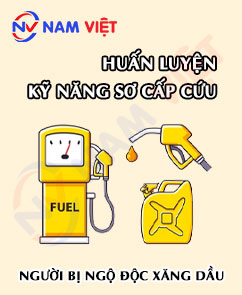First aid training for individuals choking on foreign objects
500,000 ₫
Note: The above price is calculated per person. Prices may vary depending on the number of participants in the course and market fluctuations. For more accurate pricing, please refer to the price list or contact our consulting staff directly.
Table of Contents
Toggle1. Identifying a Person Choking on a Foreign Object
a. Cases of choking
Choking occurs when an object lodges in a person’s airway and obstructs airflow. If not addressed promptly, choking can be life-threatening. Some common cases include:
- Children: Often lack proper eating and breathing skills, making them more prone to choking than adults.
- Elderly: Older adults may have swallowing difficulties or dental problems, increasing the risk of choking.
- People with digestive disorders: Digestive issues may make swallowing difficult, raising the risk of choking.
- People who are poisoned: Poisoning can impair bodily functions, increasing the likelihood of choking.
- People who consume alcohol: Alcohol impairs awareness, making it easier to swallow objects incorrectly.
- People with breathing problems or respiratory conditions: They may choke if they do not breathe properly or are not carefully monitored.
- People working in dusty or smoky environments: Inhalation of particles or improper breathing can increase choking risk.
- People eating or drinking: Swallowing food or drinks too quickly can lead to choking.

b. Signs someone may be choking
Signs of choking include:
- Difficulty breathing, speaking, or faster than normal breathing.
- Hoarse sounds, crying, or laughing without producing sound.
- Difficulty swallowing, sore throat, or pain while eating or drinking.
- Pale or bluish face and lips due to lack of oxygen.
- Nausea, discomfort, and coughing may appear.
- If the victim struggles to breathe and quickly becomes pale, they are in a dangerous situation and require immediate first aid.
If you notice these signs in those around you, especially children and the elderly, check for choking and provide immediate first aid if necessary.

c. Assessing the condition of a choking victim
Conditions of a choking victim may include:
- Difficulty breathing: The victim struggles to breathe because the object obstructs their airway.
- Difficulty speaking or hoarseness: Speech may be impaired due to airway obstruction.
- Chest pain: Pressure from the object may cause discomfort or pain in the chest area.
- Vomiting and coughing: The body attempts to expel the obstructing object.
- Loss of consciousness: Severe obstruction may cause the victim to lose consciousness.
- Pale face and labored breathing: The victim may appear pale and have worsening breathing difficulties.
Immediate first aid is required, followed by urgent medical attention.

d. Golden time for choking cases
The golden time for choking cases is critical, as this emergency can be life-threatening. The golden time to remove an obstructing object is within 4 minutes. Failure to clear the airway within 4 minutes may lead to respiratory failure and death.
If you notice someone choking, provide immediate first aid and call emergency medical services. If you are unsure how to perform the rescue, contact emergency services immediately for professional guidance.
2. Overview of First Aid Training for Choking Cases
a. What is a first aid training course?
A first aid training course is designed to teach learners both basic and advanced first aid skills. The program includes lessons and practical exercises on handling emergencies such as cardiac arrest, respiratory failure, poisoning, injuries, and other urgent situations.
The goal is to equip learners with essential skills to respond effectively to emergencies, minimize harm to themselves and others, increase survival chances, and ensure timely transfer to medical facilities.
REGISTER FOR BASIC FIRST AID TRAINING
b. Training duration
Initial first aid training:
- For employees: 4 hours.
- For first aid and emergency responders: 16 hours (2 days).
Periodic first aid training:
- For employees: 2 hours.
- For first aid and emergency responders: 8 hours (1 day).
c. Course content
- Basic principles of first aid and on-site emergency care
- Wound bandaging (principles, tools, techniques)
- Temporary bleeding control techniques (principles and methods)
- Temporary fracture stabilization techniques (principles and tools)
- Cardiopulmonary resuscitation (recognizing signs of cardiac arrest, airway clearance, breathing support, CPR guidance)
- Burn management (assessing cause and severity, on-site first aid)
- Safe victim transportation with and without stretchers for initial care
- Specific emergency care scenarios:
- Electric shock
- Drowning
- Chemical accidents
- General guidance on first aid kit use
- Practical exercises for all content areas
d. First aid training certificate
Upon completing the course, learners will receive a certificate confirming completion of the first aid training program under the Group 2 training framework as specified in Appendix IV, Decree 44/2016/ND-CP. The certificate is valid for 1 year.


3. Essential Tools for a First Aid Kit in Case of Choking
The tools required in a first aid kit for handling choking incidents include:
- Choking forceps: A specialized tool to remove foreign objects from the airway.
- Cotton and gauze: For cleaning the mouth and airway after the object has been removed.
- Saline solution or clean water: To rinse the mouth and airway.
- Gauze pads and bandages: For cleaning and dressing any bleeding after removing the foreign object.
- Phone: To call emergency services if the victim’s condition does not improve after intervention.
- First aid manual: Can be used as a reference for the first aid procedure if needed.
REGISTER FOR BASIC FIRST AID TRAINING
4. First Aid Procedure for Choking
The first aid procedure for a choking victim includes the following steps:
- Assess the victim’s condition: Ask for their name, health status, and observe signs of choking.
- Immediately call emergency services: If the choking is severe and cannot be resolved, call local emergency services or take the victim to the nearest hospital.
- Guide the victim or assist them in performing initial measures: Instruct the victim to lean forward, place the palm on the lower abdomen, and apply a quick, strong thrust from behind to help expel the object from the airway.
- If the above step fails, continue with the next measure: Place the victim’s hands on their abdomen, position one hand on the lower abdomen, and place the other hand on top to apply a strong upward thrust to the upper abdomen. This may help dislodge the object.
- If both steps fail, perform advanced rescue techniques: If the object remains, advanced measures such as chest thrusts or the Heimlich maneuver should be performed to remove the object.
- Keep the victim stable: After the object is removed, monitor and keep the victim stable. If necessary, take them to a hospital to ensure safety.
5. Benefits of First Aid Training
First aid training provides many important benefits for individuals and communities:
- Saving lives in critical situations: First aid skills enable trainees to save someone whose life is at risk, such as cardiac arrest, respiratory arrest, poisoning, injuries, and other emergencies.
- Helping others learn first aid: Trained individuals can share knowledge and experience with others, enabling the community to protect itself and reduce mortality in emergency situations.
- Reducing rescue waiting time: When trained first aiders handle emergencies on-site, waiting time for rescue teams is minimized.
- Enhancing response and reducing stress in emergencies: First aid training helps learners respond accurately and quickly, reducing stress and anxiety while waiting for help.
- Increasing survival rates and reducing fatalities: Timely and proper first aid increases survival chances and reduces complications or deaths in emergency situations.

6. First Aid Training Capacity of An Toan Nam Viet
An Toan Nam Viet is a reputable and high-quality first aid training center in Vietnam. Continuous training sessions are conducted at manufacturing workshops, factories, and construction sites nationwide (all 63 provinces of Vietnam).
REGISTER FOR BASIC FIRST AID TRAINING
Training Certification
- An Toan Nam Viet has been inspected and certified by the Department of Safety under the Ministry of Labor – Invalids and Social Affairs, granting certification for occupational safety and hygiene training. Within the Group 2 training program, the first aid skills module is included, further reinforcing our capacity in first aid training.

Training Materials and Lectures
- Before first aid training materials are used in first aid courses, they are reviewed to ensure accuracy and practical effectiveness.
- Instructors’ teaching methods are standardized according to An Toan Nam Viet standards, developed by experts in first aid training to maximize knowledge retention for trainees.
Facilities
- Controlling factors in the training room enhances teaching efficiency and knowledge absorption.
- Our training facilities provide spacious classrooms meeting standards for space, lighting, and training equipment, etc.
7. Nationwide First Aid Training Centers
An Toan Nam Viet is one of the most reputable and professional organizations for first aid training in Vietnam. With experienced instructors, modern equipment, and high-quality programs, the center has become an ideal destination for those interested in protecting lives and health.
By participating in courses at An Toan Nam Viet, you will learn basic and advanced first aid skills, including CPR for cardiac arrest, respiratory arrest, poisoning, injuries, and other emergency situations. The program is flexible and suitable for all learners, from adults to children, medical staff, rescue personnel, and the general public.
An Toan Nam Viet’s first aid training not only teaches essential life-saving skills but also fosters awareness to protect your own life and health as well as those around you. Training by experienced and highly qualified instructors ensures confidence and readiness for any emergency situation.
Register for first aid courses at An Toan Nam Viet to protect your life, health, and the community.
1 review for First aid training for individuals choking on foreign objects
No comments yet












phanminhhang341
Very good and professional first aid training unit